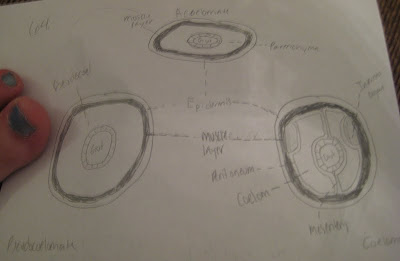

2. The biomolecule in a phospholipid bilayer is a lipid. Lipids can be found in animal fat. An example of this would be my fatty dog, Lilee.
______________Structural formula of Lipid^

5. Amino acids make up the hair or fur of my dog, Lilee. An amino acid is a molecule containing a carboxyl and an amino group that makes protein. Amino acids compose the biomolecule, protein.
__________Structural formula of Protein^
11. My dog, Lilee, uses aerobic respiration. I know this because Lilee breathes in oxygen. When pyruvic acids meet oxygen, it undergoes aerobic respiration.
The first stage of aerobic respiration is Krebs cycle. This produces CoA, CO2, NADH, ATP, FADH2, and H. The second and last stage of aerobic respiration is the electron transport chain. This produces NAD+, FAD, H+, lots of ATP, and 2H2O.
29. My dog is an amniote. If she were to become pregnant, her puppies would be encased in an amnio, a yolk sac, an allantois, and a chorian. All of these help protect her puppies. This goes the same for all reptiles, birds, and mammals who are also amniotic.
36. My dog, Lilee, is alive!! The six straits of a living organism are;
(1) They are made of cells.
(2) They use energy.
(3) They grow and develop.
(4) They reproduce.
(5) They respond to their environment.
(6) They adapt to their environment.
37. An animal that went through deuterostome development is Lilee. Animals that go through this process undergo radial cleavage. An embryonic blastopore develops into an anus whereas, its mouth develops from a second opening at the opposite end of the archenteron.
41. Ribosomes are small, spherical organelles that build protein. Proteins make up structures such as fur on animals like my dog, Lilee.
45. Multicellular is when an organism consists of more than one cell. I know that Lilee is multicellular because she is a living organism and all living organisms are made of cells.

60. ATP provides energy to both autotrophs and heterotrophs, like my dog, Lilee. Energy is released from ATP when a covalent bond between the phosphate groups are broken. In the structure to the left, you can see P's with circles around them. Those stand for a phosphate group.
66. My dog is a member of the Phylum Chordata. All Chordates have;
(1)A dorsal which is a hollow nerve chord.
(2) A notochord.
(3) A tail that extends beyond the anus.
(4) Pharyngeal pouches.






































